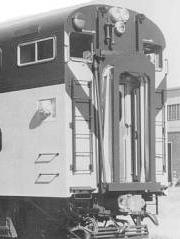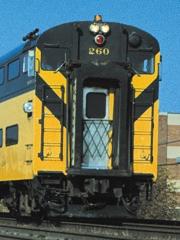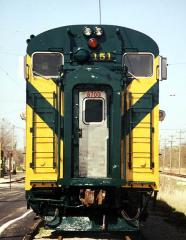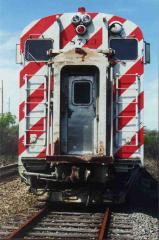 C&NW Bi-Level Commuter Cars
C&NW Bi-Level Commuter Cars

Contents
History
Chicago and North Western amassed a fleet of 292 bi-level (gallery) cars,
built by Pullman-Standard except for the first 16 which were built by
St. Louis Car Co. 280 of these cars were
used in Chicago commuter service, including one former intercity parlor
car which was converted in 1965. Remarkably, all of the commuter cars
survived until being sold to the Regional Transportation Authority (RTA)
on 31 December 1977.
The first 48 cars were built with
7˝-KW Waukesha Enginators to provide electricity for lighting and to
power two underframe-mounted Trane E-M 8-ton air conditioning units.
Locomotive-supplied steam was used for heating and some of these cars
were pulled by steam locomotives, which hardly fits the image of
such modern cars. The first group of 16 cars was built in 1955 by
St. Louis Car Co.; the remaining 32 were built the next year by
Pullman-Standard. All were delivered in the early 1950s version of
C&NW's yellow and green livery, using a yellow letterboard with
1" black separator stripes.
|
These early cars were repainted in the late 1950s with a green
letterboard and without the black separators, the livery in which
all subsequent C&NW bi-levels were delivered. In 1961, they
were rebuilt to use head-end power (HEP) for electrical needs and
to include multiple unit (MU) cabling for push-pull operation.
At some point in their career the original Venetian blinds were
removed and green-tinted windows were installed.
|
|

early livery |
|
| |

later livery |
(Lots more to say here ...)
Spotting
Visually, these cars broke down into seven distinct groups
(summarized in the table below).
The first two groups are easily recognized by their window patterns.
The cars built by St. Louis Car Co. had six large windows
on each level on either side of the entry doors, plus a narrower
square window at the ends. The 1956 Pullman-Standard cars were
similar, but lacked the smaller end windows. In addition, on one
side the rightmost windows were replaced by a pair of square windows
on the lower level and a single square window on the upper level.
(This was the location of the toilet.)
The subsequent Pullman-Standard cars have four large windows
instead of six, and the air conditioning units were relocated from
underfloor to the area above the entry doors, with large intakes
for the condensers above the doors. The 1958 intercity cars,
including 6400 which was later rebuilt into commuter coach 225,
were built with three bare condenser panels next to each other,
centered above the doors. On the 1960 cars (which came in both cab and
coach configurations), the rightmost panel was omitted, leaving just
two panels offset to the left of center. The subsequent cars were
similar, but the condensers were covered with a grille that visually
divided the area into quarters. Cab details also differed.
| Qty | |
Pct | |
Description | |
C&NW Numbers | |
North Side | |
South Side |
| 16 |
5.7% |
1955 SLC "6˝ window" |
1-16 |
 |
| 32 |
11.4% |
1956 PS "6 window" |
17-48 |
 |
 |
| 8 |
2.9% |
1960 cab cars |
151-158 |
 |
 |
| 28 |
10.0% |
1960 coaches |
49-76 |
 |
| 56 |
20.0% |
late cab cars |
159-200, 251-264 |
 |
 |
| 139 |
49.6% |
late coaches |
77-150, 201-224,
226-237, 301-329 |
 |
| 1 |
0.4% |
ex-6400 |
225 |
 |
| 280 |
100.0% |
(total) |
Cab Differences

C&NW 152 (as built) |

C&NW 260 |
The builder's photo of C&NW 152 (far left) shows how the first eight
cab cars (C&NW 151-158) looked when new. Note the gong bell above the
engineer's windshield, front-mounted horns like on an M.U. car, boiler tube
pilot, and lack of a gate in front of the door.
Compare this to C&NW 260, which except for the 1970s-addition of the
rooftop amber warning light is how the later cab cars were delivered.
Note the gong above the fireman's windshield, roof-mounted horns, solid
pilot, and gate.
|

C&NW 151 |

RTA 8713 |
At the Illinois Railway Museum after restoration, C&NW 151 (far left)
illustrates the relocation of the gong and horns, which occurred soon
after delivery, plus the subsequent replacement of the pilot with the
later-style solid design. The gong location forced the number
to be offset instead of being centered as on the later cars. The gates
and amber beacons were also added, but have been removed during
restoration. The red 8700 at the top of the door is the car's RTA
number.
RTA 8713, built as C&NW 164, again illustrates the later cab cars.
|
Roster
| |
C&NW | |
RTA/Metra | |
Bldr | |
Year | |
Qty | |
Lot | |
Plan | |
Seats | |
Note | |
| 1-16 | |
7600-7607,
7900-7901,
7608-7613 | |
SLC | |
1955 | |
16 | |
1784 | |
- | |
169 | |
"6˝ window" | |
| 17-48 | |
7650-7681 | |
PS | |
1956 | |
32 | |
6978 | |
7653 | |
161 | |
"6 window" | |
| 49-76 | |
7700-7727 | |
PS | |
1960 | |
28 | |
7002 | |
53194 | |
161 | |
| |
| 77-150 | |
7728-7801 | |
PS | |
1961 | |
74 | |
7006 | |
53194 | |
161 | |
| |
| 151-158 | |
8700-8707 | |
PS | |
1960 | |
8 | |
7002A | |
53194 | |
153 | |
cab | |
| 159-200 | |
8708-8749 | |
PS | |
1961 | |
42 | |
7006A | |
53194 | |
153 | |
cab | |
| 201-210 | |
7802-7811 | |
PS | |
1963 | |
10 | |
7023 | |
53194 | |
161 | |
| |
| 211-216 | |
7812-7817 | |
PS | |
1965 | |
6 | |
7032 | |
53194 | |
161 | |
| |
| 217-224 | |
7818-7825 | |
PS | |
1966 | |
8 | |
7034 | |
53194 | |
161 | |
| |
| 225 | |
7880 | |
PS | |
1958 | |
1 | |
W6997 | |
W53075 | |
136 | |
ex-6400, cvtd 1965 | |
| 226-237 | |
7826-7837 | |
PS | |
1967 | |
12 | |
7038 | |
53194 | |
161 | |
| |
| 251-254 | |
8750-8753 | |
PS | |
1965 | |
4 | |
7032A | |
53194 | |
153 | |
cab | |
| 255-256 | |
8754-8755 | |
PS | |
1966 | |
2 | |
7034A | |
53194 | |
153 | |
cab | |
| 257-260 | |
8756-8759 | |
PS | |
1967 | |
4 | |
7038A | |
53194 | |
153 | |
cab | |
| 261-264 | |
8760-8763 | |
PS | |
1968 | |
4 | |
7041A | |
53194 | |
153 | |
cab | |
| 301-316 | |
7838-7853 | |
PS | |
1968 | |
16 | |
7041 | |
53194 | |
161 | |
| |
| 317-329 | |
7854-7866 | |
PS | |
1970 | |
13 | |
7044 | |
53194 | |
161 | |
| |
Models
HO Scale models:
- Holgate & Reynolds:
These craftsman kit models of the 1960-1970 cars consisted of
silk-screened sides with a wood roof and floor plus soft metal
ends and detail parts. Numbers and vent details were supplied
as dry transfers. The company was acquired in 1997 by
Three Brothers Manufacturing
(below)
which has upgraded the kits.
- Three Brothers Manufacturing:
Kits #301 and #302 are the old Holgate & Reynolds models,
upgraded with a plastic roof and floor (the wood versions are also
included in the kits) and improved trucks with Intermountain wheels.
Kit #303 is a new model of the "6 window" cars (it's unclear if
these are the SLC or PS cars), also available in the orignal paint
scheme as kit #1103. Another addition is a buffet-lounge (kit #1102),
probably one of the intercity cars.
- Brass Car Sides:
Known for their etched brass overlays to provide correct sides
for plastic models (or core kits), Brass Car Sides
provides complete kits for the late C&NW cabs and coaches,
including brass end castings, a wood roof, printed-circuit board floor,
window glazing, and details.
- Walthers:
Injection-molded plastic models of the 1960 coach
(#932-6251)
and cab
(#932-6261)
cars.
These are nice models, but the choice of the relatively uncommon
1960 cars rather than the far more common later cars was unfortunate.
The cab details are correct for those later cars, which means the cab
cars are a mix which doesn't accurately portray any actual car (though
they do create the right impression).
- Kato:
Injection-molded plastic models of the
1956 Pullman-Standard "6 window" cars in late paint scheme
and after conversion to HEP
(#35-6041)
plus the 1960 coach
(#35-6032)
and cab
(#35-6022)
cars.
(Details.)
These are very nice models, improved over the Walthers models with
free-rolling trucks and better detailing though the striping on the
cab cars incorrectly lines up with the color separation on the car
sides. (Walthers got this right.)
The 1956 cars are especially nice to have as they were a modest
part of the fleet but were quite distinctive.
However, two years after Walthers modeled the 1960 cars,
Kato's choice of these same cars (which represent less than 13%
of the C&NW fleet) instead of making the minor-but-visible
change to the air conditioning intake to represent nearly 60% of
the final fleet is perplexing. Also like Walthers, Kato modeled
the cab details of these later cars, so the cab cars are not
accurate representations of any group. Perhaps someone will
manufacture a grille overlay so one can turn these cars into
accurate models of the 1961-1970 cars.
N Scale models:
- Con-Cor:
Injection molded models of post-1960 cab and coach cars.
(Walthers:
cab and
coach.)
- Wheels of Time:
This company offers a model
(Kit #114)
which represents the 1956 Pullman-Standard "6 window" cars
after repainting but before conversion from steam heat to HEP
(and MU for push-pull operation).
The kit is actually a highly-detailed model of SP's class 85-MLC-2,
21 cars built by ACF in March 1957 and numbered SP 3710-3730,
but it is a good stand-in for the C&NW cars.
- Kato:
Only partly commuter cars, Kato's
C&NW "400" Boxed Train Set
looks nice and includes what appears to be an accurate model of 1956
coach-buffet car 903 but has many errors:
- EMD E8A 5022-A has steam-generator equipment; the bi-level "400"
trains needed HEP-equipped power.
- 4-window coaches 700 and 705 were part of the 1958 order but the
models are of the 1960 commuter cars, identified by the two bare
condenser panels above the doors instead of three as on the 1958
cars. (The model of 903 gets this right.)
- Coach-parlor car 6400 appears to use the same body as the coaches
and thus has the same issues as 700 and 705. (6400 is the intercity
car rebuilt for commuter use in 1965 as CNW 225; I've not seen a
photograph of it as 225 but doubt that the condenser configuration
was changed.)
- Cab-coach 154 is a good model of the 1960 cab cars (they fixed the
striping issue from the earlier HO models) but these were purely
commuter cars, never (or exceedingly rarely) used on the intercity "400"s.
Large scale models:
- K-Line:
- 4620C - 21" bi-level "400" (4 pack)
- 4620E - 21" bi-level "400" (2 pack)
- 4620F - 21" bi-level "400" (2 pack)
Bibliography
- Kohnmann, Keith.
"CNW Bi-Level Gallery Cars, from Con-Cor Kits."
Railmodel Journal,
May 2001, p. 51.
- Klein, Fred.
Prototypes for N scale passenger cars part 5: Streamlined lightweight smooth side cars.
WWW page.
Railmodel Journal,
May 2001, p. 51.
- Phillips, Dave.
"C&NW Gallery Cars."
Rail & Wire,
Issue 179, September 1999.
- Randall, W. David, and William Anderson.
The Official Pullman-Standard Library, Vol. 9: Chicago & North Western.
Godfrey, Illinois: Railway Production Classics, 1990.
- Randall, W. David and Alan R. Lind.
From Zephyr to Amtrak.
Park Forest, Illinois: Prototype Publications, 1972.
- -.
7600 Series Coach Specification Sheet One.
WWW page.
- -.
Cab Control Car Specification Sheet One.
WWW page.
- -.
Metra – Wikipedia.
WWW page.
- -.
Passenger Car Photo Index – Metra to Metro North.
WWW page.
- -.
Southern Pacific Passenger Cars, Volume 1: Coaches and Chair Cars.
Pasadena, California: The Southern Pacific Historical & Technical Society, 2003.
|
Copyright © 2002-2005,2007-2008,2010,2020, Karl L. Swartz. All rights reserved.
All trademarks mentioned herein belong to their respective owners.
Karl Swartz <karl@kls2.com>
|
|


|




